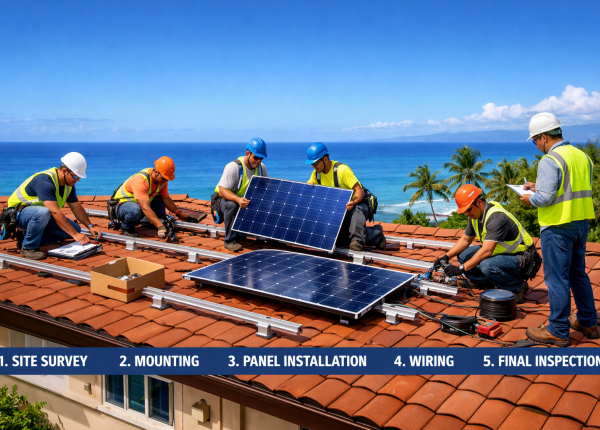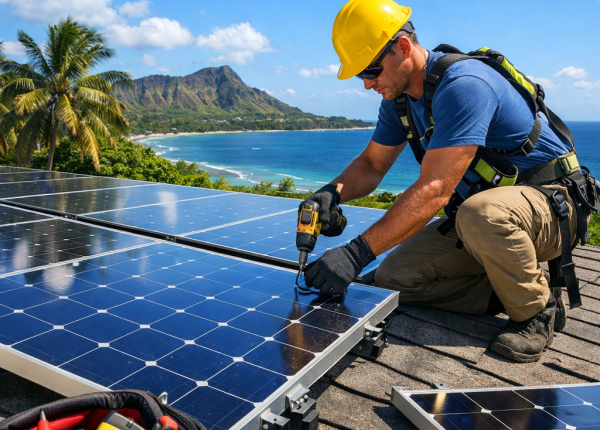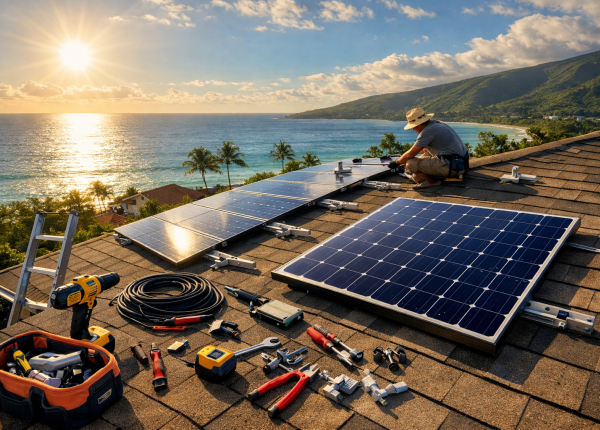Solar vs Renewable Energy: Understanding the Difference
Understanding the Power Behind Clean Energy
Ever wondered what sets solar power apart from renewable energy? It’s a common mix-up. While people often use the terms interchangeably, they’re not identical. In Hawaii—where sunlight is abundant and energy independence is a top priority—understanding this difference helps homeowners and businesses make smarter energy decisions.
Solar energy is one type of renewable energy, but the renewable category also includes wind, geothermal, hydro, and bioenergy. Each source plays a vital role in reducing fossil fuel dependence and moving Hawaii toward a sustainable future.
As Forbes reports, the clean energy transition is reshaping economies worldwide, and Hawaii is at the forefront of that shift.
By the end of this guide, you’ll know:
- How solar fits into the broader renewable landscape.
- The advantages and trade-offs of each clean energy source.
- How Hawaii’s renewable transition benefits residents and businesses.
Let’s dive into the heart of solar vs renewable energy and see how they work together to power Hawaii’s future.
What Makes Solar Energy Unique Among Renewables?
Solar energy converts sunlight into electricity using photovoltaic (PV) panels. While it’s part of the renewable family, solar stands out for its scalability, accessibility, and strong performance in Hawaii’s tropical environment.
Key Benefits of Solar Energy:
- Endless sunshine: Hawaii receives one of the highest solar irradiance levels in the U.S., according to the National Renewable Energy Laboratory (NREL).
- Low maintenance: Once installed, solar panels require minimal upkeep.
- Flexible applications: Works for homes, businesses, and large-scale solar farms.
- Energy independence: Reduces reliance on imported fossil fuels.
Energy.gov emphasizes that solar is one of the most cost-effective and environmentally friendly ways to meet energy demand, especially in high-sun regions like Hawaii.
Pro Tip: Pair photovoltaic systems with PV storage solutions to maximize energy efficiency and maintain power even during nighttime hours.
Comparing Solar Power and Other Renewable Energy Sources
To understand solar vs renewable energy, it helps to compare solar with other renewable technologies. Each has a role to play in creating a balanced, reliable energy grid.
Solar Energy: Harnessing Hawaii’s Sun
How it works: Converts sunlight into electricity through photovoltaic panels.
Best for: Homes, businesses, and utility-scale installations.
Main advantage: Clean, quiet, and scalable.
Challenge: Output decreases on cloudy or rainy days.
Pro Tip: Combine solar with energy-efficient air conditioning to reduce your overall energy load and boost long-term savings.
Wind Energy: Power from Pacific Breezes
Hawaii’s coastal winds and elevated terrain make wind power a perfect companion to solar energy.
How it works: Uses turbines to capture kinetic energy from the wind.
Best for: Areas with strong, consistent wind currents.
Main advantage: Generates electricity when solar isn’t available.
Challenge: May impact local wildlife or scenic views.
When it comes to solar vs wind energy, solar dominates during the day while wind often fills in the gaps at night—creating an ideal renewable pairing.
Hydropower: Energy from Flowing Water
Hawaii’s smaller rivers limit hydropower potential, but it still plays a niche role.
How it works: Converts flowing or falling water into mechanical energy.
Main advantage: Provides stable, predictable output.
Challenge: Limited scalability on island terrain.
Geothermal Energy: Heat from the Earth
How it works: Taps into underground heat to produce steam and electricity.
Main advantage: Offers continuous, 24/7 energy production.
Challenge: Restricted to geothermal zones like the Big Island.
As Greentech Media notes, combining geothermal with solar and wind helps create grid stability for regions with varying weather conditions.
Bioenergy: Power from Organic Matter
How it works: Uses organic waste, crops, or plant residues to generate heat or electricity.
Main advantage: Reduces waste while utilizing local resources.
Challenge: Complex production and limited scalability for small islands.
Bioenergy contributes to Hawaii’s renewable mix by converting waste into usable energy, complementing the cleaner technologies like solar and wind.
How Solar Power Fits Within Hawaii’s Renewable Energy Goals
Solar’s Leading Role in Hawaii’s Clean Energy Vision
Solar energy is the backbone of Hawaii’s renewable strategy, producing over 30% of the state’s electricity. From residential rooftops to massive solar farms, installations across the islands continue to grow.
Hawaiian Electric reports that solar energy now supplies a substantial portion of Oahu’s daytime power needs, making it central to Hawaii’s 2045 clean energy goal.
Pro Tip: Learn more about Hawaii’s solar terms in Solar Power Terms: Hawaii’s Complete Solar Energy Glossary.
Renewable Energy Mix for Grid Stability
While solar dominates daytime production, Hawaii’s grid stability relies on a balanced renewable mix—solar for day, wind for night, and geothermal for constant base load. Energy storage systems, such as batteries and EV chargers, help bridge the gaps and enhance reliability.
Consider electric vehicle charging solutions that double as energy storage for added flexibility.
Economic and Environmental Impact
According to Energy.gov, clean energy initiatives like solar and wind help reduce carbon emissions, improve air quality, and support economic growth. Hawaii’s renewable shift creates jobs, stabilizes energy prices, and reduces dependence on imported oil—all while protecting its natural beauty.
Real-World Examples of Solar and Renewable Energy in Hawaii
Use Case 1: Residential Solar + Battery Systems
Thousands of Hawaii homeowners use rooftop solar paired with batteries to cut electricity bills by up to 90% and maintain power during outages.
Use Case 2: Commercial Renewable Microgrids
Hotels and schools are adopting hybrid systems combining solar, wind, and battery storage. These microgrids provide steady energy during storms and reduce operational costs by 30–40%.
Use Case 3: Community Solar Projects
Community-based solar programs now allow renters or those without rooftops to share in renewable benefits. This inclusive model makes clean power more accessible across the islands.
These examples show how solar vs renewable energy isn’t a competition—it’s a partnership shaping Hawaii’s sustainable future.
Best Practices and Common Mistakes When Choosing Renewable Energy
Do:
- Combine solar with wind or geothermal for balanced generation.
- Invest in quality storage solutions for backup power.
- Take advantage of Hawaii’s tax credits and rebates.
- Customize systems for your specific location and usage.
- Keep up with system maintenance and cleaning.
Don’t:
- Assume solar alone can meet all your needs.
- Ignore local interconnection and grid policies.
- Overlook system warranties or installer certifications.
Pro Tip: Work with experts like Alternate Energy Hawaii for electrical services and roofing solutions to ensure safe, efficient, and long-lasting solar installations.
Building Hawaii’s Sustainable Energy Future
The difference between solar power and renewable energy lies in scope. Solar is a powerful type of renewable energy, but true sustainability in Hawaii depends on a balanced mix—solar for abundance, wind for consistency, and geothermal for stability.
As Forbes and Greentech Media highlight, regions that diversify their renewable mix see the greatest gains in efficiency, reliability, and long-term savings.
Ready to explore your options? Visit Alternate Energy Hawaii—your trusted local partner for solar, storage, and clean energy solutions.
Frequently Asked Questions About Solar vs Renewable Energy
Q1: Is solar energy the same as renewable energy?
No. Solar is one type of renewable energy, while renewable energy also includes wind, geothermal, hydro, and bioenergy.
Q2: Why is solar power popular in Hawaii?
Because of consistent sunlight, high electricity prices, and strong sustainability goals, solar is one of the most cost-effective solutions statewide.
Q3: What’s the main advantage of solar vs renewable energy alternatives like wind or hydro?
Solar panels are easy to install, require minimal maintenance, and can scale from small homes to large utility projects.
Q4: Can Hawaii reach 100% renewable energy?
Yes. Hawaii is on track to achieve 100% renewable electricity by 2045 through a combination of solar, wind, and geothermal energy with storage systems.
Q5: How can I switch to solar energy in Hawaii?
Contact Alternate Energy Hawaii for a free consultation. Their team designs, installs, and maintains systems customized to your energy needs.


